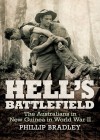Book Review - Hell’s Battlefield: The Australians in New Guinea in World War II
Hell’s Battlefield: The Australians in New Guinea in World War II
Written by: Phillip Bradley,
Allen & Unwin, Sydney, 2012,
ISBN: 9781743317556, 506 pp
Reviewed by: John Moremon, Centre for Defence and Security Studies, Massey University
Close to 20 years ago, Peter Stanley, the respected and industrious historian who nowadays heads the Centre for Historical Research at the National Museum of Australia, declared that there was a ‘green hole’ in Australian military historiography. He noted that the Second World War campaigns in New Guinea, especially post-1942, were some of our most significant yet least studied. He inspired historians and writers to explore the neglected battlefields. Not least of these is Phillip Bradley, this being his fifth book relating to New Guinea.
Unlike his previous books, which examined particular campaigns or battles, mostly in 1943–44, Hell’s Battlefield provides an overview of land campaigns from 1942 until the war’s end. Bradley is to be commended for recognising that, while we have filled in much of the ‘green hole’, we have left a gap in the market, as it has been years since the arrival of a single-volume account.
For readers seeking stirring tales of Australian (and even some American) battles, Hell’s Battlefield will not disappoint. Bradley knows how to deliver a good yarn. He is also familiar with much of the ground. He takes us on a journey that starts with the ill-fated defence of New Britain, a tale of survival (for some) and tragedy (for most), including the massacre at Tol, which provides the characteristic title of the opening chapter, ‘See you in hell, fellers’. What follows is a string of celebrated characters and stories. Of course we meet Captain Sam Templeton and his ‘B’ Company, 39th Battalion, on the Kokoda Trail — a chapter kicked off with the legendary Corporal John Metson: ‘Shot through the ankle and unable to walk, [he] dragged himself through the jungle in the tracks of his mates.’ We also read of courage and sacrifice at Milne Bay, Gona, Wau, Shaggy Ridge, the Torricellis, Buin Road, and seemingly every place in between. Highlighted is the valour of each Victoria Cross recipient, such as Bruce Kingsbury, ‘Diver’ Derrick and Bert Chowne. And there are other heroes, such as Billy Cook, who survived Tol, and ‘Bull’ Allen, the stretcher-bearer whose photograph (carrying an unconscious American soldier across his shoulders on Mount Tambu) graces the cover. The focus here is on good blokes whose exploits secured them a place in the Anzac legend.
The book’s jacket notes that Bradley’s books are characterised by ‘an intimate knowledge gained from his many trips to the battlefields, complemented by his archival research skills and his many unique interviews with New Guinea battlefield veterans’. It adds that Bradley has been described as ‘One of the finest chroniclers of the Australian Army’s role in the New Guinea campaign.’ Indeed, one of Bradley’s strengths is his chronicling ability, and many readers will be drawn to the book for this reason. While some stories may be overused and clichéd, the commercial market demands that they are repeated. Fortunately, Bradley has another strength I admire: he refrains from the Boys’ Own Adventure jingoism employed by other purveyors of the legend. On the other hand, the title Hell’s Battleground is one of those superlatives that not only boosts book sales but also contributes to the fantasy that Australians encountered the toughest fighting in the world (to borrow a line from the war correspondent George Johnston).
A third strength is that only occasionally does Bradley get things badly wrong. To pull out one example, on pages 170–71 he accuses Brigadier Porter of slighting his own 30th Brigade, when in fact Porter was presenting a frank assessment to Major General Vasey that the brigade lacked the tactical-level leadership and training to have any chance of breaking through at Sanananda. In getting it wrong on this occasion, Bradley reinforces the notion (part of the legend) that there was a serious disconnect between ‘diggers’ and their commanders. In fact, Porter was saving the lives of some of his men, as his battalions were subsequently extracted for intensive training.
This is not a book for those readers already familiar with the New Guinea campaigns and who simply seek to further their understanding of how the war in the islands was conducted. While a fine storyteller, Bradley is not a trained and skilled historian. His endnotes and bibliography show extensive use of primary documents, but only to gather more well-worn stories of the ‘diggers’ caught up in Hell’s Battlefield. He does not pursue important issues such as strategy, command, joint operations, logistics, doctrine and training, technology, environmental and human impacts, or the physical and mental toll on those who survived. For example, we are not told the personal cost of ‘Bull’ Allen’s shows of courage: mental breakdown.
Hell’s Battlefield succeeds in bringing tales of New Guinea to a wide audience. We could benefit now from others perhaps working together to produce a single-volume scholarly study of these same campaigns.



